
Age-Related Reactions to a Traumatic Event
Describes how young children, school-age children, and adolescents react to traumatic events and offers suggestions on how parents and caregivers can help and support them.
An earthquake is a shifting of the earth’s plates, which results in a sudden mild to strong shaking of the ground. The shaking may be sideways, up and down, or wave-like, and can occur over very large regions. Earthquakes can last from a few seconds to several minutes and usually start with a rumbling noise that can be low in volume or as loud as a freight train. Earthquakes occur suddenly and unpredictably. They can happen at any time of the year. Most earthquakes are mild and go unnoticed. However, they can be severe enough to result in extensive damage to communities, including collapsing schools, homes, bridges, dams, highways, and even tall buildings. Earthquakes aftershocks are quakes that take place in the same area as the main quake, and they are common. The frequency of aftershocks depends on the size of the main earthquake. A foreshock is a quake that occurs before a large earthquake.
Being prepared beforehand is the best way to help children and family members recover after an earthquake. Because severe earthquakes are rare, many people may forget about the risk. To improve their preparedness, families should:
Knowing what to do during an earthquake can help families stay safe. Consider the following:
During an earthquake, families should:
After the shaking stops, families should:
To address children’s reactions immediately after an earthquake, parents and caregivers can:
Since earthquakes are unexpected and can be very destructive, being in one can be very terrifying. Families can be separated, with hours passing before knowing if their loved ones are safe. If there is a lot of damage, there could be a significant number of people injured or killed. These events can be particularly difficult for those with mobility issues.
People may continue to encounter sights, sounds, smells, sensations, and inner feelings that remind them - even years afterwards - of the earthquake. Common reminders include cracks in the wall, rumbling noises, destroyed buildings, smells of fire and smoke, and aftershocks. Those with the most severe earthquake-related experiences and losses have the most severe and persistent posttraumatic stress and grief reactions.
Other common reactions include:
After an earthquake, most families will recover over time, particularly with the support of family, friends, and organizations. The length of recovery depends, in part, on how frightened people were and the extent of the damage and loss in the community. Children’s functioning and recovery will be influenced by how their parents and caregivers cope after the earthquake. Some families will be able to return to their normal routines rather quickly, while others will have to contend with repairing damage to their home and possessions, finding medical care, moving to a new community, and facing financial hardship. Specialized trauma- or grief-focused mental health services can help children and adolescents recover from the psychological consequences of an earthquake.
Below are resources to support children, families, and communities to recover after an earthquake.

Describes how young children, school-age children, and adolescents react to traumatic events and offers suggestions on how parents and caregivers can help and support them.
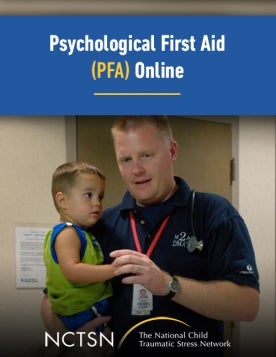
Includes a 5-hour interactive course that puts the participant in the role of a provider in a post-disaster scene. This course is for individuals new to disaster response who want to learn the core goals of PFA, as well as for seasoned practitioners who want a review.
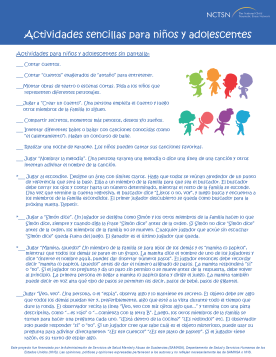
Ofrece ideas de actividades para padres y cuidadores cuyas familias se están refugiando en el lugar, sin electricidad y recuperándose de un huracán u otro evento.

Helps child welfare agencies support children and youth during and after natural disasters. This toolkit is for child welfare staff, supervisors, and administrators who work with and on behalf of children, youth, and families who experience a natural disaster.
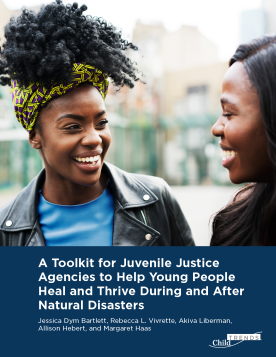
Helps juvenile justice agencies support children and youth during and after natural disasters. This toolkit is for juvenile justice staff, supervisors, and administrators who work with and on behalf of children, youth, and families who experience a natural disaster.
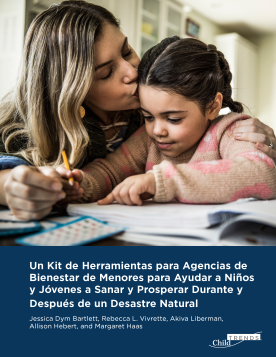
Ayuda a las agencias de bienestar infantil a apoyar a los niños y jóvenes durante y después de los desastres naturales.
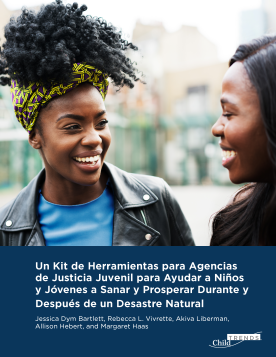
Ayuda a las agencias de justicia juvenil a apoyar a los niños y jóvenes durante y después de los desastres naturales.

Aims to help survivors gain skills to manage distress and cope with post-disaster stress and adversity. This course utilizes skills-building components from mental health treatment that have been found helpful in a variety of post-trauma situations.
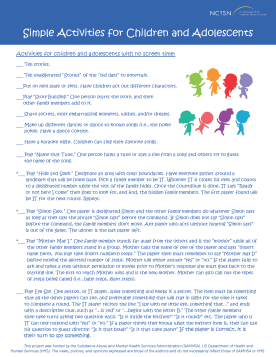
Offers activity ideas to parents and caregivers whose families are sheltering in place, evacuating their homes, or social distancing due to any type of disaster or event.

Summarizes the Psychological First Aid (PFA) eight core actions. This card is a quick reminder of the eight core actions involved in Psychological First Aid.

Helps parents talk to their kids about the disasters they may face and know how best to support them throughout—whether sheltering-in-place at home, evacuating to a designated shelter, or helping your family heal after reuniting.
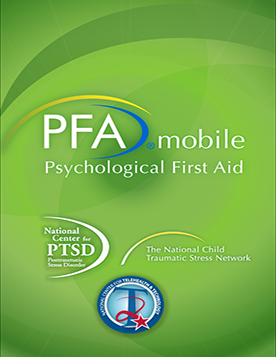
Lets responders review PFA guidelines and assess their readiness to deliver PFA in the field.